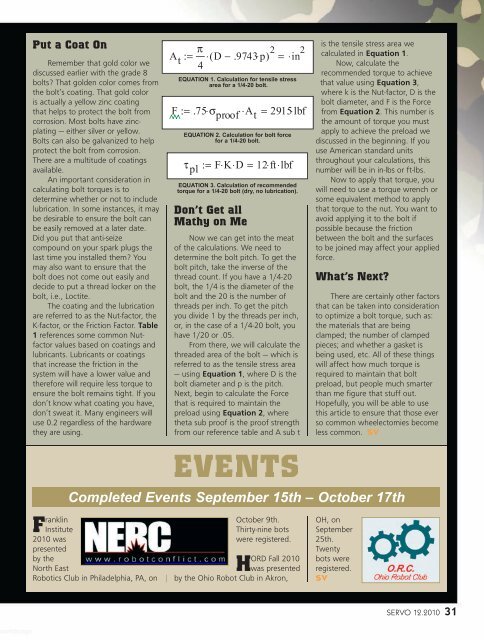You also want an ePaper? Increase the reach of your titles
YUMPU automatically turns print PDFs into web optimized ePapers that Google loves.
worldmags<br />
Put a Coat On<br />
Remember that gold color we<br />
discussed earlier with the grade 8<br />
bolts? That golden color comes from<br />
the bolt’s coating. That gold color<br />
is actually a yellow zinc coating<br />
that helps to protect the bolt from<br />
corrosion. Most bolts have zincplating<br />
— either silver or yellow.<br />
Bolts can also be galvanized to help<br />
protect the bolt from corrosion.<br />
There are a multitude of coatings<br />
available.<br />
An important consideration in<br />
calculating bolt torques is to<br />
determine whether or not to include<br />
lubrication. In some instances, it may<br />
be desirable to ensure the bolt can<br />
be easily removed at a later date.<br />
Did you put that anti-seize<br />
compound on your spark plugs the<br />
last time you installed them? You<br />
may also want to ensure that the<br />
bolt does not come out easily <strong>and</strong><br />
decide to put a thread locker on the<br />
bolt, i.e., Loctite.<br />
The coating <strong>and</strong> the lubrication<br />
are referred to as the Nut-factor, the<br />
K-factor, or the Friction Factor. Table<br />
1 references some common Nutfactor<br />
values based on coatings <strong>and</strong><br />
lubricants. Lubricants or coatings<br />
that increase the friction in the<br />
system will have a lower value <strong>and</strong><br />
therefore will require less torque to<br />
ensure the bolt remains tight. If you<br />
don’t know what coating you have,<br />
don’t sweat it. Many engineers will<br />
use 0.2 regardless of the hardware<br />
they are using.<br />
F ranklin<br />
Institute<br />
2010 was<br />
presented<br />
by the<br />
North East<br />
Robotics Club in Philadelphia, PA, on<br />
π<br />
At D .9743 p<br />
4 ⋅ − ⋅( )2in<br />
2<br />
:=<br />
= ⋅<br />
EQUATION 1. Calculation for tensile stress<br />
area for a 1/4-20 bolt.<br />
F := .75⋅ σproof ⋅At = 2915lbf ⋅<br />
EQUATION 2. Calculation for bolt force<br />
for a 1/4-20 bolt.<br />
τpl := FK ⋅ ⋅D = 12⋅ ft ⋅lbf<br />
EQUATION 3. Calculation of recommended<br />
torque for a 1/4-20 bolt (dry, no lubrication).<br />
Don’t Get all<br />
Mathy on Me<br />
Now we can get into the meat<br />
of the calculations. We need to<br />
determine the bolt pitch. To get the<br />
bolt pitch, take the inverse of the<br />
thread count. If you have a 1/4-20<br />
bolt, the 1/4 is the diameter of the<br />
bolt <strong>and</strong> the 20 is the number of<br />
threads per inch. To get the pitch<br />
you divide 1 by the threads per inch,<br />
or, in the case of a 1/4-20 bolt, you<br />
have 1/20 or .05.<br />
From there, we will calculate the<br />
threaded area of the bolt — which is<br />
referred to as the tensile stress area<br />
— using Equation 1, where D is the<br />
bolt diameter <strong>and</strong> p is the pitch.<br />
Next, begin to calculate the Force<br />
that is required to maintain the<br />
preload using Equation 2, where<br />
theta sub proof is the proof strength<br />
from our reference table <strong>and</strong> A sub t<br />
EVENTS<br />
October 9th.<br />
Thirty-nine bots<br />
were registered.<br />
HORD Fall 2010<br />
was presented<br />
by the Ohio Robot Club in Akron,<br />
is the tensile stress area we<br />
calculated in Equation 1.<br />
Now, calculate the<br />
recommended torque to achieve<br />
that value using Equation 3,<br />
where k is the Nut-factor, D is the<br />
bolt diameter, <strong>and</strong> F is the Force<br />
from Equation 2. This number is<br />
the amount of torque you must<br />
apply to achieve the preload we<br />
discussed in the beginning. If you<br />
use American st<strong>and</strong>ard units<br />
throughout your calculations, this<br />
number will be in in-lbs or ft-lbs.<br />
Now to apply that torque, you<br />
will need to use a torque wrench or<br />
some equivalent method to apply<br />
that torque to the nut. You want to<br />
avoid applying it to the bolt if<br />
possible because the friction<br />
between the bolt <strong>and</strong> the surfaces<br />
to be joined may affect your applied<br />
force.<br />
What’s Next?<br />
There are certainly other factors<br />
that can be taken into consideration<br />
to optimize a bolt torque, such as:<br />
the materials that are being<br />
clamped; the number of clamped<br />
pieces; <strong>and</strong> whether a gasket is<br />
being used, etc. All of these things<br />
will affect how much torque is<br />
required to maintain that bolt<br />
preload, but people much smarter<br />
than me figure that stuff out.<br />
Hopefully, you will be able to use<br />
this article to ensure that those ever<br />
so common wheelectomies become<br />
less common. SV<br />
Completed Events September 15th – October 17th<br />
OH, on<br />
September<br />
25th.<br />
Twenty<br />
bots were<br />
registered.<br />
SV<br />
SERVO 12.2010 31<br />
worldmags




